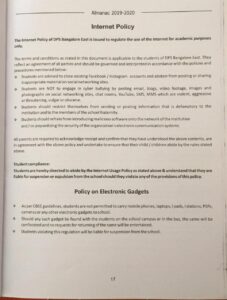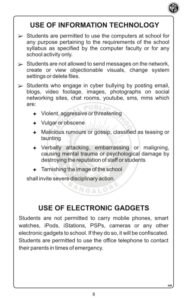From Twitter to Tik Tok, social media has become an integral platform for students’ lives, be it for social, political, or educational reasons. As a result, social media is now a powerful tool of persuasion, with as much influence over shaping students as families or schools. Given this immense influence, an important question has been raised–Should schools regulate students’ social media usage? If so, why, and to what extent?
Plenty of reasons are cited for regulation. Schools and parents are concerned for the safety and well-being of their children, with social media being notorious for often snatching that away from them.
Scandals such as the ‘Bois Locker Room’ which revealed that several schoolboys were brashly circulating and commenting on photos of underage schoolgirls without their consent or knowledge, are a case in point. International cases such as the ‘Blue Whale Challenge’ exist too, wherein teenagers (who were often students) were targeted through an online ‘challenge’, eventually inciting several suicides.
Delhi Police files another FIR in Bois Locker Room case after girl receives threats for exposing abusive chat. (@arvindojha)#ITVideo pic.twitter.com/htUrV8lZLN
— IndiaToday (@IndiaToday) June 8, 2020
These cases evidence the unprecedented scope of danger and exploitation that social media presents, from strangers and peers alike. It’s no wonder then that numerous studies suggest that social media negatively impacts students’ mental health.
Efforts have been taken by Indian authorities to protect students from these dangers. For example, after the ‘Bois Locker Room’ incident, the CBSE shared cyber safety handbooks with their students and issued warnings against cyberbullying.
Some measures have been more overarchingly punitive than others though. Last year, the Madurai Bench of the Madras High Court also directed the Union government to ban the use of (the now-banned) TikTok. The app was considered a medium of indecent exposure, and a danger to children after officials speculated that pornographic content was being shared on the platform.
Beyond top-down mechanisms, regulation at the school level is also considered essential to safeguarding the interests of the school itself, by preventing information leakage which may have detrimental effects on not only the school, but on the students themselves. According to a representative from an elite private school in Bengaluru, students are advised to be cautious when posting online, as colleges and employers may look into their social media accounts to determine the ‘character’ of potential candidates.
These are valid concerns. However, they do not acknowledge the fact that although students are often the most vulnerable to the threats of social media, they are also the best placed to understand how to tackle them. Considering how pervasive and useful social media has become in our lives, it is questionable as to whether ‘safety’ alone can justify the policing of a student’s usage of social media altogether.
Presently, the plan of action, if any, in private schools seems to involve a curated set of rules that control what students may post on social media, and in some cases, whether or not they are allowed to use social media at all. While the force with which these policies are implemented varies, the institutional wariness towards social media remains seems fairly consistent.


Yet, despite these regulations, students seem to be persistently using social media in ways that they deem appropriate. According to Shruti Gopal*, a Grade 11 student from a private school in Bengaluru, “Most of us are still on Instagram and Snapchat even though they’ve asked us to ‘avoid it’. But no one really talks about it at school. If something happens online, good or bad, we don’t tell our teachers because we don’t want them to check everyone’s accounts and make us delete them.”
Clearly, regulation, as it exists today, is neither welcomed by students, nor it is effective in achieving its goals. In some instances, it is even counterproductive, leading students to be more secretive about their online activities.
There are two possible explanations for this outcome. Firstly, social media regulation in most schools operates by instilling a fear of institutional intervention and judgement about what students post on social media. One of Bengaluru’s highest-ranking private schools requires students and their parents to sign a disciplinary contract with the school which includes (among other disciplinary rules) agreeing not to post any information about the school without permission, and allowing the school to check their social media accounts whenever required. [Editor’s note: The existence and particulars of this document have been confirmed by a school representative although they did not provide access to the same.]
This suggests that the regulations aren’t targeted towards protecting students, as much as they are towards protecting the standard industrialised school from the fluidity and dynamism of social media instead.
Comprehensive sexuality education empowers young people to take informed decisions about their sexuality and relationships in a way that protects their health. @MoHFW_INDIA @UNICEFIndia @MinistryWCD @PMOIndia @NHPINDIA @nhm_up @drharshvardhan pic.twitter.com/j3rneJl8NH
— Chikitsa Mitra (@ChikitsaMitra) August 14, 2019
Secondly, this method of regulation does not take into account that social media is a lucrative platform for students to obtain information and take part in conversations that are otherwise inaccessible to them in school. Conversations on sex, sexuality, gender, race, and caste, which are either erased, compromised, or avoided in the mainstream curriculum because of discomfort or social taboo, can be easily accessed on social media. Yet somewhat ironically, conflicting ideas and prejudices around such topics tend to be the centres of bullying, abuse, and harassment on social media.
So, how can schools manage social media usage without violating a student’s liberty, while simultaneously also protecting them from misuse and manipulation?
A start in this direction may be to shift the focus from the ‘whats’ and ‘whys’, to how a student uses social media instead. Regulation cannot be limited to a set of rules to abide by: it must be a continuous process that enables students to navigate social media in a safe and productive manner, in tandem with other parts of their lives.
To do this, schools must confront social media as an inherent part of students’ lives, instead of separating their physical and digital worlds. As Laura Tierney, Founder of The Social Institute writes, “For kids who are digital natives, there is no separation. Their world is digital. How tweens and teens act online is how they act, period. Everything they do, everywhere, is a reflection of their values and character.”
So, if schools and parents want to make sure that students are exposed to the ‘right’ information and behave responsibly, they need to take the onus of educating students on the matters–which students fall back on social media to address–in the safe and controlled environment of the classroom.
In the last few months, the internet is everything for many of us & our children. It offers risks and possibilities both. Make sure to include all these points while having the ‘#OnlineSafetyTalk‘ with children. Follow this space as we share more information around #OnlineSafety. pic.twitter.com/6a9MoFJwBb
— Aarambh (@aarambhindia) July 6, 2020
According to the founder of Social Media Matters Amitabh Kumar, it is important to “demystify” ideas of sex, sexuality, drug use, dating, and other conversations that are usually discouraged, if not altogether avoided in the classroom. By addressing students’ curiosities in a protected environment, they are equipped with the ability to make judgments for themselves without demonizing or glorifying the things presented to them online. Says Kumar, the “Offline and online have completely converged. Our approach towards this convergence in every step of a child’s life is important. Schools can use this opportunity to leverage something that students are so interested in and make it educational.”
Therefore, social media regulation cannot remain an isolated concern but must be paired with facilitating open and non-judgmental conversations between students and teachers, in an educational format rather than through policing. By helping students draw a line between ‘concept’ and ‘reality’, schools will help students in recognising and addressing dangerous or inappropriate situations. Furthermore, this approach not only educates and empowers students, but also compels them to reflect on their actions and its effects on others, instilling in them a sense of accountability that transcends the rulebook.
All in all, yes, schools definitely have a responsibility to ensure that their students are neither exploiting nor being exploited by social media. However, there are alternate avenues to prohibition and policing. By embracing social media as a potential academic ally, schools can definitely help cultivate a safe, productive, and inclusive reality at the convergence between the online and the offline.
Featured image courtesy of Blogtrepreneur (CC BY 2.0) | *Names changed






